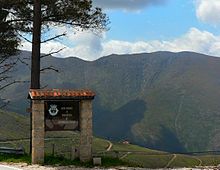Alvoco da Serra
| Alvoco da Serra | ||||||
|---|---|---|---|---|---|---|
|
||||||
| Basic data | ||||||
| Region : | Centro | |||||
| Sub-region : | Beiras e Serra da Estrela | |||||
| District : | Guarda | |||||
| Concelho : | Seia | |||||
| Coordinates : | 40 ° 18 ′ N , 7 ° 40 ′ W | |||||
| Residents: | 466 (as of June 30, 2011) | |||||
| Surface: | 37.57 km² (as of January 1, 2010) | |||||
| Population density : | 12 inhabitants per km² | |||||
| Height: | 680 m | |||||
| Postal code : | 6270-012 | |||||
| politics | ||||||
| Mayor : | António Antunes Alves ( PS ) | |||||
| Address of the municipal administration: | Junta de Freguesia de Alvoco da Serra Rua do Correio, 8 6270-012 Alvoco da Serra |
|||||
| Website: | www.jf-alvocodaserra.pt | |||||
Alvoco da Serra is a place and a municipality in the Beira region in the northern interior of Portugal .
Geography and traffic
The place is located in the western foothills of the Serra de Estrela on the banks of the Ribeira de Alvoco , halfway between Loriga and Unhais da Serra . It is accessible by road 231 , which leads to the district town of Seia, 27 km to the north.
history
Romans settled here, as evidenced by coins found in 1884 in the municipality of Aguincho. They also left bridges and a well-preserved Roman road . The current place was probably created in the course of the resettlement policy during the Reconquista . The first documented mention of Alvoco comes from the lists of royal surveys of 1220 .
King D. Manuel I gave the place its first town charter in 1514 and elevated it to a small town ( Vila ). Alvoco da Serra also became the seat of its own circle. In the course of the administrative reforms after the Liberal Revolution in 1822 and the subsequent Miguelistenkrieg , the district was dissolved in 1836 and Loriga was incorporated . Alvoco da Serra has belonged to Seia County since the Loriga County was dissolved in 1855 .
In 1856 the first textile factory for wool processing was built in Alvoco, which was named Fundeira after its location in the rear (Port .: Fundo) district . With the Engenho da Serra ( 1877 ) and the Fábrica do Meio ( 1879 ), two further textile factories were established. In 1928 the community received a nationwide electricity and telephone network. During the 20th century, the community subsequently experienced industrial decline and factories closed.
Attractions
Among the monuments of the municipality a Roman bridge, the 1918 built city fountain include Fonte da Praça , and a tower from the 19th century at the highest point of the Serra da, the Estrela 1957-2008 a building of the local radar support point of the Air Force Força Aérea Portuguesa was , and which today houses a guard of the Guarda Nacional Republicana , shops and a visitor center of the Serra da Estrela.
A large number of sacred buildings are listed buildings in the municipality, including the baroque parish church Igreja Paroquial de Alvoco da Serra from 1724, and after its patron saint also Igreja de Nossa Senhora do Rosário (English: Church of Our Lady of the Rosary).
The community lies in the nature park Parque Natural da Serra da Estrela (PNSE), hiking trails have been created.
administration
Alvoco da Serra is the seat of a municipality of the same name ( Freguesia ) in the district ( concelho ) of Seia , in the Guarda district . On June 30, 2011 the community had 466 inhabitants on an area of 37.6 km².
The following places are in the municipality:
- Aguincho
- Alvoco da Serra (administrative headquarters)
- Outeiro da Vinha
- Vasco Esteves de Baixo
- Vasco Esteves de Cima
Personalities
The linguist and politician Sandra Brito Pereira was born here in 1977. She belongs to the Portuguese Communist Party and has been a MEP since 2019.
Web links
- Official website of the local government
- Alvoco da Serra on the district administration's website
Individual evidence
- ↑ a b www.ine.pt - indicator resident population by place of residence and sex; Decennial in the database of the Instituto Nacional de Estatística
- ↑ Overview of code assignments from Freguesias on epp.eurostat.ec.europa.eu
- ↑ History of the municipality of Alvoco da Serra, accessed on November 16, 2013
- ↑ www.monumentos.pt , accessed on November 16, 2013
- ↑ ditto
- ↑ ditto
- ↑ ditto





